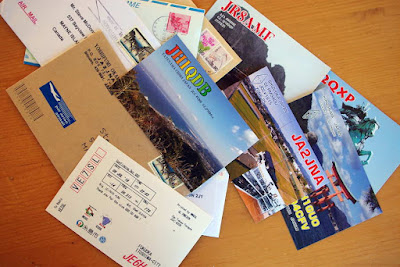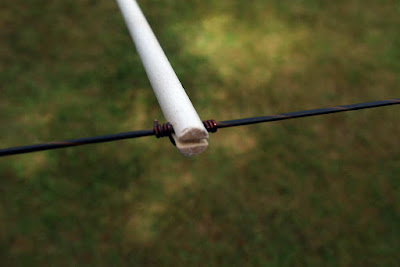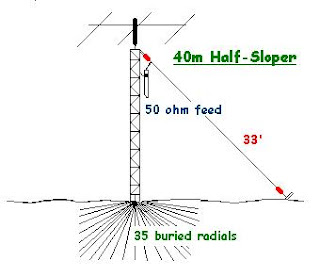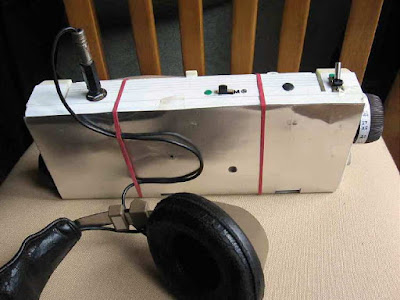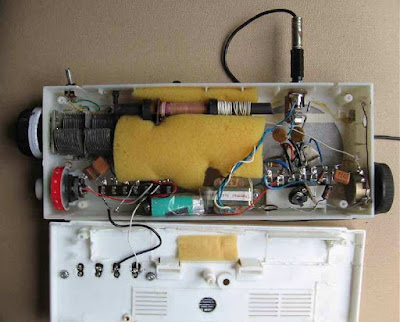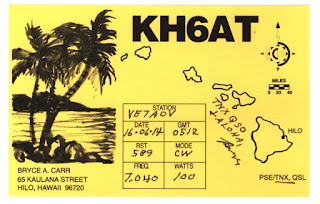Author Archive
 Hunting For NDBs In CLE 234
Hunting For NDBs In CLE 234

This coming weekend will see the 'Barn Door' CLE, mentioned in a previous blogspot here. Listeners are required to challenge themselves by listening on a receiver using a wide enough bandwidth that several kHz worth of signals can be heard at once.
The 'immersive' effect this wider bandwidth mode provides is much different than when listening with narrow filters and can make digging out IDs a lot more challenging. Throwing in some mid-summer lightning noise makes it even tougher, but if it were easy, it just wouldn't be much fun!
Many, including myself, will be using homebrew single MOSFET regenerative receivers, often called a '1AD' since they normally use just one active device. I've just finished testing my own version and have been able to hear some night time DX so hopefully the band will be quiet enough to hear some signals during the CLE.
From CLE organizer Brian Keyte, here are the details explained ... and good luck to all participants!
Hi all
It is an opportunity to bring back to life basic kinds of receiver - anything with low selectivity which allows you to hear NDBs on several frequencies simultaneously - leaving the barn door wide open!
Listening with 'back to basics' equipment often gives very satisfying and unexpected results. It can also show us ways of improving our listening when operating more normally.
Our last Barn Door CLE was No. 209 in July two years ago.
Here comes our fifth 'Barn Door' CLE. Between us there will be a great variety of different receiver types in use.
Days: Friday 27 to Monday 30 July 2018
Times: Start at ## 11 a.m. on Friday 27th, your LOCAL time
End at ## 3 p.m. on Monday 30th, your LOCAL time
Frequencies: Centred on 360 kHz (see below)
NDBs: NOT MORE than 100 'normal' NDBs including any UNIDs
(That is not intended to be a target to reach)
We are all asked to listen with NON-SELECTIVE receivers - i.e. with a WIDE
filter or NO filter. Your 'barn door' should be open wide so you could
hear, at the same time, any NDBs 2 kHz away on both sides of your receiver
setting - E.g. NDBs on 348, 349, 350, 351 and 352 kHz with the receiver set
to 350 kHz.
## The extra daytime hours on the first and the last day might help some of
us planning to listen out of doors.
You could listen with:
1. A simple home-made receiver, such as a single transistor set with regen.
(e.g. based on the sets used by Mike, Finbar and others).
2. OR - an Ultralight receiver, maybe one converted to cover the NDB
frequencies with a modified aerial.
3. OR - an 'antique' receiver (e.g. Eddystone, R1155, Scott, etc.)
Perhaps you have something you've not switched on for many years?
4. OR - a normal receiver but with NO filtering, or using a WIDE FILTER,
(not less than about 2 kHz and no selection of an audio filter).
You choose how wide a RANGE of frequencies you will listen in, CENTRED ON
360 kHz. You could choose 350-370 kHz or 330-390 kHz or 260-460 kHz, etc.
(This allows each of us to choose a +/- range with enough NDBs to
match our equipment's capability. It will also allow our loggings to
be compared in the Combined Results, at least around 360 kHz).
Logs should show NOT MORE THAN 100 NDBs please (if more than 100, the
harvester program will 'drop' the loggings furthest from 360 kHz).
There are several extra targets you could set yourself - maybe the wide
bandwidth, the centre frequency of 360 kHz and the 100 loggings limit do not
challenge you enough!
You could listen only in daytime and/or away from home.
Or how about NDBs on 360 +/- 10 kHz or even +/- 5 kHz?
The Twente remote receiver in Holland could be interesting to use for the
whole of your (only) CLE log.
( Go to http://websdr.ewi.utwente.nl:8901/ and read the advice there:Select AM and 'MAX IN', enter e.g. 354.7 in the frequency box and change the
filter's limits to 2 or 3 kHz from the centre frequency on both sides )
We’ll summarise everyone's equipment on the first page of the combined
results, so please describe:
The RECEIVER/AERIAL you used and the FILTER(s) selected, if any.
If homebrew, please quote: the total number of active devices used – e.g.
1 for a single transistor stage ( 1AD ) - the transistor/valve types,
whether using regen., etc.
All the usual procedures for making logs apply:
Send your CLE log to NDB List, if possible as a plain text email and not in
an attachment.
Please show on EVERY LINE of your log:
# The full date (or Day No.) and UTC (the day changes at 00:00 UTC).
# kHz - the beacon's nominal published frequency, if known.
# The Call Ident.
Show those main items FIRST on each line, before other optional details
such as Location, Distance, etc. Please send your complete log with
CLE234 and FINAL in the Subject line.
Whether you are a first time CLE-er or a regular, make your log interesting
to everyone by showing your own location and your equipment details.
Do feel free to share any comments you have on this unusual event.
Joachim or I will send the usual 'Any More Logs?' email at about 17:00 UTC
on Tuesday 31st so that you can check that your log has been found OK.
Make sure your log has arrived on the List at the very latest by 08:00 UTC
on Wednesday 1 August. We hope to complete making the combined
results a day or so later.
However you choose to take part, we hope you will find your 'back to basics'
listening enjoyable and worthwhile.
P.S. NOT FOR YOU?
Listening without narrow filters is not going to revolutionise our hobby!
But there ARE some unexpected benefits and advantages:
1. Hearing several beacons on a few adjacent frequencies at the same time
becomes easier as you get practice at recognising them by listening to their
very different audio tones. At first, when listening to a random frequency
setting, you may hear just one or two beacons. But after listening for a
little while you realise that there are three - - four, maybe more, all of
them audible without altering any of the receiver controls.
It is a skill that gives satisfaction as you improve.
2. Hearing multiple beacons like that can be useful because, with no extra
tools, you can hear NDBs over a wide frequency range much more quickly than
usual, perhaps spotting the arrival of new UNIDs or the return of occasional
beacons. (To protect your hearing, keep your receiver gain controls fairly
low, except on very quiet frequencies).
3. With normal listening it is easy to miss any NDBs that have abnormal
carrier frequencies or non-standard offsets. With 'Barn Door' listening
they won't escape because everything is let through.
4. When using a wide filter, you may be surprised by hearing some Broadcast
Station signals (e.g. harmonics) among the NDBs and you will be able to
identify them.
With a narrow filter, often you may not recognise an AM signal as audio
- it just sounds like nondescript 'hash' affecting a wide range of
frequencies around the central carrier.
Maybe listeners will report some other good things about their barn door
listening during the CLE - and probably some bad things too!
Do join in if you can.
Brian
----------------------------------------------------------
From: Brian Keyte G3SIA ndbcle'at'gmail.com
Location: Surrey, SE England (CLE coordinator)
----------------------------------------------------------
Don't forget that help and chat regarding NDB DXing can be had on the ndb group list here.
 6m … Where’d The Magic Go?
6m … Where’d The Magic Go?

This summer's 6m sporadic-E (Es) DX season is now well past the half-way mark and things have been different ... a lot different. For me, the past 40 plus summers of activity on the magic band have always been interesting, if not down right exciting ... particularly when the band opens to Europe from the west coast.
These usually very short-lived paths have been my main interest for the past several years and the bread and butter mode is normally a fast CW exchange, usually taking less than 20 seconds before signals would vanish, as the always quirky west coast path to Europe would jump to another region. But this has all changed dramatically.
As well, it seems that this summer, the normal SSB and CW modes have been largely abandoned by a huge percentage of the crowd, in favor of FT8, the weak-signal digital QSO mode originally developed with 6m in mind.
I have seen many strong openings involving loud FT8 signals from various parts of North America but when tuning down to the CW/SSB section of the band, found nothing but ghostly silence! Gone are the familiar voices of friends met every summer for decades or the recognition of an old friend's fist on CW ... for me personally, most of the magic was missing this summer. I wonder if this is all part of the natural evolution of amateur radio or does the FT8 revolution signal the long term fate for many of the older conventional modes?
I have seen many strong openings involving loud FT8 signals from various parts of North America but when tuning down to the CW/SSB section of the band, found nothing but ghostly silence! Gone are the familiar voices of friends met every summer for decades or the recognition of an old friend's fist on CW ... for me personally, most of the magic was missing this summer. I wonder if this is all part of the natural evolution of amateur radio or does the FT8 revolution signal the long term fate for many of the older conventional modes?
There appears to be a lot of new activity brought to the band by this mode, and many are experiencing the magic band for the first time. I have heard at least two dozen or more VE7 calls on 6m this summer that I have never heard before and this is a very positive thing! From what I can tell, many of the new stations on the band may have makeshift or simple antennas, such as verticals or dipoles and not something larger and are just getting their feet wet on the band.
FT8 allows for two-way weak signal work (a few db below audible limits) that the traditional modes would not support, and simpler stations, without big antennas, can now join the fun. I often see many of the newer stations calling CQ but not hearing their numerous replies, which leads me to think that their receive-capability does not yet match their transmit-erp ... perhaps they just have a lot of local noise or are running more power than they can properly deal with, something they should think about. Often the new FT8 stations will continually CQ, sometimes as long as 90 minutes at a time and create a lot of unnecessary and waterfall obliterating QRM on the band for those that do have good antennas and can hear what they do not. I'll do another blog later regarding FT8 on 6m, and what I have observed this summer.
Here on the west coast, up until last summer, it was fairly normal to have a few short-lived Es openings to Europe. You had to always be on your toes to catch these as they would vanish as suddenly as they appeared. The best of these was back in June of 2012 when a mid-morning opening produced 31 CW contacts in DL, F, SP, CT, ON, GM, IT, LZ, EI, G, S5, I and EA8. Nine new countries were put in the log that morning as the Es clouds danced around, shifting the propagation from one country to another, every other minute. This was the magic band at its best!
Like last summer, this year has produced almost zero trans-Atlantic propagation from VE7 land, other than contacts with CT1 and EA8, both on FT8. Perhaps some external factors are changing the band enough that this path will vanish permanently ... only time will tell.
Dave, K7RWT, recently pondered if it may have something to do with the north magnetic pole migration over the past several years as it moves to the north-northwest at ~60km per year.
 |
| Track the pole's movement here. |
Most mornings, the Europeans are into the east coast early, often times making into the central states and occasionally into the southwestern states:
 |
| July 18th courtesy: http://www.on4kst.org/chat/index.php |
Later in the afternoon, it has not been unusual to see widespread JA to North America action, usually going straight overhead and as far back as the New England states and down to Florida!
 |
| July 20th courtesy: http://www.on4kst.org/chat/index.php |
There have been several openings between here and JA, sometimes lasting for several hours. So far I've worked about 200 JAs this summer and judging by the flood of daily QSLs arriving from Japan, many are newcomers to the band (the FT8 effect?), often indicating that I was their 'first VE' contact on 6m.
One particularly interesting 'opening' from here happened in the wee hours, starting just after 2300 local time and ending just after 0200, as all west coast operators were sawing logs. A morning check of my FT8 decodes indicated many strong signals from Japan, Taiwan, China, Korea and Hong Kong. I'm sorry that I missed out as the VR2 would have been a new country for me.
The non-JA stations heard were:
BM6GJL PL02
HL1BRU PM37
HL2IFR PM37
BG4QNE PM01
VR2VAZ OL72
BV2FB PL05
BV6CC PL03
BV1EK PL05
BM3GFU PL04
Thanks to Paul, K7CW, for doggedly sorting through my all-night decode file which may be viewed in full here.
With just a couple of weeks left in the normal Es season, it will be interesting to see if FT8's extra few db will extend it longer than usual!
 |
| Overnight decodes July 8-9 |
BM6GJL PL02
HL1BRU PM37
HL2IFR PM37
BG4QNE PM01
VR2VAZ OL72
BV2FB PL05
BV6CC PL03
BV1EK PL05
BM3GFU PL04
Thanks to Paul, K7CW, for doggedly sorting through my all-night decode file which may be viewed in full here.
With just a couple of weeks left in the normal Es season, it will be interesting to see if FT8's extra few db will extend it longer than usual!
 My New 80 / 40m Antenna
My New 80 / 40m Antenna
 |
| 80 / 40m wire vertical groundplanes, now removed |
For the past several years I have employed wire vertical groundplane antennas for both 80 and 40m, mounted a few feet from the ocean.
In the fall I layout the ground radials on the grass and in the spring, roll all of them up again. The main reason for going to the vertical was to eliminate problems with my 80 / 40m half-slopers when using my 1929 single tube power oscillators during the windy conditions usually encountered during the mid-winter '29 BK QSO Party.
The flexing between the tower's telescoping mast sections and the Yagi antennas that form part of the sloper's 'top hat' , cause the half-sloper's impedance or resonance to change ever so slightly. The directly-coupled oscillators respond to these minute antenna changes by constantly shifting frequency by several hundred Hertz, as their output load changes. These high winds can make the low-power oscillator difficult to copy under weak signal conditions as it suddenly jumps frequency. The verticals were immune to this 'wind effect' and performed very well ... sort of.
I've noticed, over the years, that the verticals seemed to produce a much better signal out on the eastern edges of the continent than they do in the central states and in the closer western (PNW) states. I decided to see if an inverted-V might produce a higher takeoff angle and give me a better signal in mid-continent and an 'OK' one on the east coast. The half-slopers on the other hand, always seem to produce a good signal both near and far, but could usually not be used with the one-tube power oscillators when it was windy ... which, during winter here on the coast, is a lot of the time!
Following the removal of the old wire verticals and several days of antenna building, the new 80 / 40m dual inverted-Vs were hoisted to the top of my 85' Balsam. After pruning for resonance, I have been able to run some comparisons between the 40m V and my present 40m half-sloper. The 80m half-sloper had already been decommissioned as it required the changing of a jumper to use and I was never able to resonate it properly for some reason. Oddly there was no problem with either the 40m or 160m half slopers, fed at the same point, as both resonated easily.
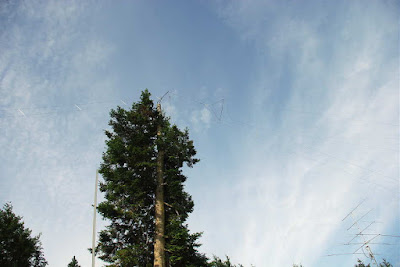 |
| The new 80 / 40m dual inverted-V dipoles |
The dual dipoles, both resonated to the CW portion of each band, are separated every 10' by 24" varnished and painted hardwood spreaders.
The old 40m sloper has always been a really great performing antenna (except for the power oscillator / mast flexing problem) and it was the one used for my 300mW Tuna Tin Worked All States, back in the fall of 2000. I've had good success with both the 40m version and the 160m version, with 159 countries now confirmed on topband using the diminutive 130' wire.
The 'Half-Sloper' was given a close analysis by antenna guru Jack Belrose, VE2CV, and described in QST of May, 1980. In his article, "The Half Sloper - Successful Deployment is an Enigma", he found that the radiation pattern was almost identical to that of a top-loaded monopole, fed against ground. The radiation field was largely vertically polarized and omni-directional while a lesser component, about 10db down, was horizontally polarized and coming from the sloping wire. The horizontal component had a figure-eight radiation pattern, slightly favoring the direction of the wire. He suggests that this antenna should be avoided due to the difficulty in getting it properly tuned.
My own experience with half-slopers have been mostly very positive, in spite of the tuning problems with the 80m version. To me, it seems like an ideal low band antenna for the small backyard, if you can get it to tune correctly. Assuming you already have a tower with some beams to add top-loading, hanging half slopers for the low bands takes up very little space. With omni-directional low angle radiation along with some higher angle horizontal radiation, all in a small footprint, what could be better for a simple wire antenna? Well, hopefully, my new high inverted-V!
For the past couple of weeks, as described earlier, I have been comparing the new 40m inverted-V against my 40m half-sloper, 'A-B' style, in real time, using the KiwiSDR network of online receivers. It seems that about 75% of the time, my old half-sloper, is just a few db better than the new V ... after all of the work involved, these results were both surprising and somewhat disappointing!
Perhaps I shouldn't be surprised after all, since the inverted-V configuration for a dipole is certainly less than ideal and the included angle in my antenna's normal position is only about 90 degrees. As well, the feedline attenuation losses for the new antenna are about 1db higher than those of the sloper. During the winter, I will be able to move one leg over to the far side of my neighbour's property which will open the apex up to a full 180 degrees. Recent testing at this angle has made the antennas neck and neck with one beating the other about 50% of the time, but the inverted-V is always better to the closer states.
Unfortunately, I have nothing to compare the new 80m antenna against but from listening to the signal on various SDR's around the continent and into the Caribbean, I have every confidence in it providing a much better signal than I have previously been able to muster on that band ... it should really help during the '29 BK QSO Party and the next NRR CW Party.
So what has been accomplished with the new installation? I have gained what appears to be a very good performer on 80m, as well as a 40m antenna that seems to be as good as the known good performing half-sloper, and should not cause any frequency-hopping with the one-tube power oscillators. My signal into the nearby PNW and central states has been improved. As well, now I can also avoid the annual radial deployment and retrieval needed for the wire verticals.
I'm still testing both antennas but conditions have been less than co-operative over the past few weeks. Hopefully when propagation picks up again, some of the European and far out Pacific SDRs can be used to further compare the two antennas ... there may yet be more to come!
 Barn Door Wide!
Barn Door Wide!
 |
| Alfred Morgan 1 Tube Regen courtesy: KC9KEP |
The next CLE event will be the "Barn Door" listening activity which requires listeners to use receivers without the usual narrow filters. Some of the older tube radios can do this easily as can most homebrew receivers ... especially the regens!
If you've never listened to the NDB band with a wide bandwidth, it is a fascinating experience! If conditions are normal, you can typically hear a half dozen or more signals, all at various pitches, vying for your attention. It's almost as if you have plunked yourself down in the middle of the NDB forest of signals, and they are coming at you from all directions.
Many choose to use one of their homebrew receivers for this event, often as simple as a '1AD' or a '1 Active Device' circuit. A recent posting to the ndblist group from CLE organizer Brian Keyte (G3SIA), described just how much fun can be derived from such a simple radio. I'll let Brian's words speak for themselves below:
Recently I've had a few requests to provide details of my 1-transistor receiver, as used on my recent Scotland holiday and back in April 2009 for our first CLE for simple receivers. (There's still time to try making something for our next CLE145).
Here goes:
In March 2009 I was tempted to try following in the footsteps of Mike Tuggle and Finbar to see if I, as a complete D-I-Y beginner, could make a very simple 1-transistor NDB receiver. The story of making and using my own '1AD' (single active device) may help anyone also wondering whether to try some simple D-I-Y construction for CLE145, our second Listening Event for basic receivers.
I started by rounding up some likely old radios and a TV from my junk box and tried to see what I had in them that might be useful for a 1-transistor regen. receiver. From a list of the transistor types that I'd found, Mike identified a BF362 as probably the only suitable one. It is a 'normal' N-P-N silicon transistor (a BJT - bipolar junction transistor - as opposed to a field effect transistor like the MOSFETs) and is intended for low power high frequency applications. My background in making anything using transistors was just about nil and I knew almost nothing about them. The first challenge was removing the BF362 from its circuit board (a small board designed to amplify incoming UHF TV signals). Trying to play safe, I sawed round a big chunk of the actual board having snipped off most of the other components. A bit of brute force was needed as well as the hacksaw. Tests with a meter then showed that I should be able to solder to Collector, Base and Emitter without overheating the transistor. (Google helped when I entered ' BF362 data sheet ').
From the discarded MW / LW receivers there were several 2-gang variable capacitors and their tuning coils wound on ferrite rods - and of course lots of fixed capacitors and resistors. Many years ago a friend had passed to me the result of his construction of a basic amateur receiver (Heathkit RA1). That was useful because of the lack of a circuit board - the components were just soldered to lugs, most with still usefully-long wires. It also had a full list of parts and simple advice on construction. One of the old portable receivers I'd found had a plastic case that looked suitable for housing things (about the right size and shape, easy to drill, etc.).
First I tried a lash-up of the basic components on-the-bench (i.e. on the dining room table!) using the simplest transistor circuit without any regen. Trying my normal aerials, including a 100 metre long wire, I could weakly hear a few broadcast stations in the LF part of the MW band. Complete silence where there should have been NDBs - and my nearest, 316 EPM, is only 5 km away. When I tried adding regen. it proved to be an uncontrollable beast - stray capacitance effects due to all the loose connecting wires, etc. (I had made no use of a soldering iron yet!).
It seemed there was nothing for it but to start mounting the main components in the case - something I had wanted to do only after getting some real results. I had to try and guess where to site the components for likely best performance, ease of operation, etc. With no metal casing, it seemed to be a good idea to put a grounded copper wire as a 'busbar' round part of the case. That might help reduce any hand capacity effects and it would be useful for making the several ground connections including the '-' side of the little PP3 9v battery. Where possible the metal cases of the potentiometers were grounded to it too.
I had only just started fixing components in the case when Sue and I needed to move up to Lincolnshire for 5 days. That turned out to be good, as I would be well away from temptations to continue the component searches for 'something a bit better' and I could concentrate on what should be the fun part. There was a good ground connection there but I was limited to a 30 metre long wire aerial. With regen. working, that proved to be long enough to get some results from Broadcast stations, though still not loud. I was making slow progress by trying out different component values etc. and by the time came to come back home I had only heard TWO beacons. One, 338 FNY Doncaster/Sheffield International (Robin Hood Airport), only 15 miles away, was faint but fairly easy to find. The other, 365 KIM Humberside and also about 15 miles away was very faint and I only managed to hear it once. Listening during the evenings didn't add any more NDB loggings at all. I was very disappointed and ready to give up the project, but Sue reminded me I had said that if I heard just one NDB during the 5 days I would consider it a success!
Returning to Surrey my luck changed. Without making any alterations, I tried the set using my 100 metre long wire - and it was transformed! During a few minutes at dusk I heard about 25 beacons, mostly weak but clear - the 30 metre aerial in Lincolnshire must have been the problem. Listening briefly again later that evening, several European countries were there - and to my surprise I suddenly stumbled on OZN 372 (Greenland) among the loudest and clearest. That made me wonder if a Canadian beacon was possible, so I tried for DF 350 more or less at random as one of the more likely ones. Setting the receiver to 350 kHz could be difficult with no frequency markings yet, but then I noticed that it would be halfway between my locals FOS 348 and WOD 352, both of whose idents could be heard at the same time. But no luck!
Then, at about 01.15 and just before bed, I tried again. After a minute or two there appeared a weak intermittent carrier and then - sure enough - about 5 cycles of a definite 'DF' before it faded and was gone. Can you imagine my delight? Ten days after starting as a complete D-I-Y beginner, a 1-transistor device made entirely of a few junk box components was getting me Deer Lake, almost 4,000 km away (2,500 miles) in Newfoundland. After that I thought the set justified having a name, so it was christened 'Max' (contradicting its minimal design!).
The next morning I took Max to try it out when genuinely portable using a long fence not far from here. Midday conditions this time but, with the necessary short aluminium rod pushed into the ground, it gave around 25 beacons in about 10 minutes, including Wales, Belgium, Guernsey and France. Another advantage of a simple portable receiver - there are lots of places with very long ungrounded wire fences that I've noted on our walks. Then at the end of the month Sue and I had a week's holiday at a self-catering cottage on the Isles of Scilly, 50 km into the Atlantic off the far South-West of England. Travelling by train and ship (no car), my AR7030 receiver and power supply couldn't make it into my rucksack but Max did, a fraction of the weight, together with about 100 metres of light wire to drape on the hedgerows beside the cottage. Listening mainly at daytime I heard over 100 NDBs. Again, the signals were mostly quite weak, but crystal clear.
Back home I made a few overdue improvements - replacing most of the remaining twisted wires with soldered connections, fitting a terminal block for the aerial and earth, adding a little switch to select one or both of the capacitor gangs and changing connections in the output transformer giving a considerable increase in volume. I had wondered whether my reception of DF had really happened, despite the detailed notes that I had made at the time. Then early one morning there was DF again, much louder than before and it persisted for several minutes.
I used the set of course for our first 'Barn Door' listening event for basic receivers, CLE116, during Easter weekend 2009. I chose to listen only within two hours of midday using a long wire or one of my fixed passive loops and I just managed to reach 100 NDBs. 14 of the loggings were of beacons over 400 km away.
In June this year, with CLE145 coming at the end of July, Max needed to be re-awakened and tested before taking it with us to Scotland. It had always suffered a little from hand capacity effects - touching some parts caused minor changes in frequency, as did the aerial being blown about by strong winds, etc. I discovered that one of my old PC keyboards had a big metalised screen under the keys. This cured all those problems merely by placing it (fixed with rubber bands!) over the front of the receiver. It also stops an occasional 'fizzing' kind of interference if I slide the first few inches of the headphone lead under the rubber band to hold it against the screen (see picture). I assume that problem was caused by some kind of RF getting through to the 'phones.
The attached pictures show Max's front view, the inside view with the back cover unscrewed and the circuit diagram.
In the front view the main tuning knob is at the top right hand side, still with primitive frequency markings on it! (35 = 350 kHz, etc.).
The regen. control is just visible at the bottom left hand side.
The top right hand switch extends the tuning range below 300 kHz by adding the second half of the variable capacitor.
(The top central switch is a refinement that allows the tuning to cover just the Medium Wave broadcast stations by using a different winding).
In the inside view, the main components are:
The transistor on its hacked bit of white circuit board which can be seen centre right.
The windings on the ferrite rod at the top are, left to right, the original main tuning coils, aerial coupling and the regen. coil.
The bottom right potentiometer is the regen. control.
The 'floating' pot. is the base bias control.
The large top left knob is main tuning, (I tried adding a fine tuning capacitor in parallel, but it added operating complication without any advantage and I removed it)
The bottom left pot. (still as in the original set) is spare, but it incorporates the battery ON/OFF switch.
The battery, wrapped in plastic in case it shorts things, can be changed using the hinged flap.
(However the battery drain is about 1 mA, so the battery would last for many months if I listened for an hour every day!)
The output matching transformer is next to the battery.
As you can see, my approach has been very 'Heath Robinson' and a real hit-and-miss affair, so don't put much reliance on it. The set does work pretty well, but I'm sure circuit design experts will see lots of things than could be improved - and not just the quality of the soldering! Others are likely to use different transistor types and component values and some connections may be different. A MOSFET would be expected to perform better.
In case you haven't used a regeneration set before, the regen. control allows feedback of some of the RF signal to the main tuning circuit. As the regen. knob is increased from zero it increases the apparent signal strength considerably. Broadcast stations get much louder and a very local NDB would just be heard from its audio ident (a 400 Hz or 1020 Hz Morse tone). Turning the regeneration control up further continues to increase the signal strengths until suddenly beat notes start to be heard when you tune across any carriers. Now you hear the NDB signals much as 'real' receivers would when using their CW setting and no filter (or a very wide one).
The regen. could be increased even further, but eventually the set starts to fizz or wail loudly and becomes a 'dirty' transmitter - not useful!
If you have read as far as this you must have already built a simple set or are at least a bit tempted to!
If you have a little spare time, do give it a try. It really is a fun project and when you start to get results it is like reliving all over again those early days when you were delighted by your first DX loggings - only this is even more satisfying!
I'm grateful to Mike and Finbar for their encouragement and suggestions. I sent details of their sets to the List on 10th June in my email introducing the 'Barn Door CLE145' in late July. It would be good to hear details from any others with working sets or who are well on their way to having them.
Good listening!
Brian
Now if this is something that might interest you, filling a log page of NDBs heard on your own little creation, then there is still plenty of time to whip something together. If you prefer 'modern', then Mike and Brian's circuits might be a good place to begin experimenting or you could just grab one of your old Handbooks and check out the simple regenerative circuits described ... from the '30s on up! Just beef up the L and C values enough to get you down below the broadcast band and you're in business.
There is also a ton of stuff on the web via the vintage magazine and book collection available at the American Radio History website here, with enough info to keep you at the workbench for a long time.
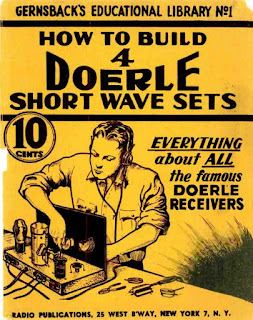 |
| courtesy: American Radio History |
Here is the CLE info, direct from Brian:
Our 233rd Coordinated Listening Event is only just over, but Joachim and I
want to tell you a little about something special coming for our next CLE,
27th - 30th July.
For CLE234 we’ll have one of our occasional ‘Barn Door’ CLEs.
It will be an opportunity to bring back to life basic kinds of receiver -
anything with low selectivity which allows you to hear NDBs on several
frequencies simultaneously – “leaving the barn door wide open!”.
Our last Barn Door CLE was No. 209 in July two years ago.
Listening with 'back to basics' equipment often gives very satisfying and
unexpected results. It can also show us ways of improving our listening
when operating more normally.
To take part, you could use any one of the following:
1. A simple home-made receiver, such as a single transistor set with regen.
(e.g. based on the sets used by Mike Tuggle, Finbar and others).
2. OR - an ultralight receiver (maybe one converted to cover the NDB
frequencies with a modified aerial).
3. OR - an 'antique' receiver brought back to life (e.g. Scott,
Eddystone, R1155, etc.). Most of those are anything but ultralight!
4. OR - a normal receiver but with NO filtering, or using a WIDE FILTER,
(not less than about 2 kHz and with no selection of an audio filter).
Your 'barn door' should be open wide enough for you to hear any NDBs
on at least five adjacent frequencies all at the same time - E.g. NDBs on
348, 349, 350, 351 and 352 kHz with the receiver set to 350 kHz.
Listening to one NDB and ignoring several others of different pitch can be
quite a challenge - but it is very satisfying when you find how quickly it
becomes easier to do.
It may take a while to prepare for some of those ways of listening,
especially the first - hence this ‘Early Warning’!
The attached guide *** (click here) from the past by Mike Tuggle may help you if you are thinking of using a basic D-I-Y receiver.
The ‘Early Advice’ and ‘Final Details’ for the CLE will follow about 9 days
and 6 days before the event, earlier than usual to help you to get ready.
Good Listening!
Brian
-----------------------------------------------------------------
From: Brian Keyte G3SIA ndbcle'at'gmail.com
Location: Surrey, SE England (CLE coordinator)
----------------------------------------------------------------
 Hunting For NDBs In CLE 233
Hunting For NDBs In CLE 233
 |
| YLD - 335kHz courtesy: http://www.ve3gop.com/ |
This coming weekend will see another monthly CLE challenge. This time the hunting grounds will be 335.0 - 349.9 kHz.
For those unfamiliar with this monthly activity, a 'CLE' is a 'Co-ordinated Listening Event', as NDB DXers around the world focus their listening time on one small slice of the NDB spectrum.
A nice challenge in this one is to hear YLD - 335, located in Chapleau, Ontario.
'YLD' runs just 100W into a 100' vertical but is well-heard throughout North America and many parts of Europe under the right conditions. Listen for its upper-sideband CW identifier (with your receiver in the CW mode) on 335.415 kHz.
Summer lightning storms may provide additional listening challenges but today's lightning map of North America looks surprisingly quiet ... maybe we will get lucky. It can't however, be any worse than last month's CLE, where widespread lightning was reported by almost every participant.!
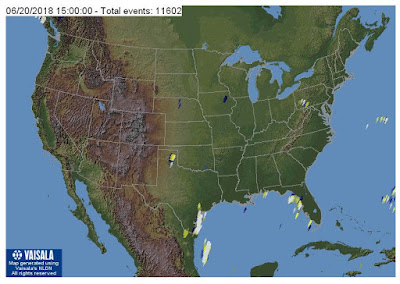 |
| courtesy: http://thunderstorm.vaisala.com/explorer.html |
If you are interested in building a system for the new (U.S.) 630m band, the CLE will give you the chance to test out your MF receiving capabilities and compare against what others in your area might be hearing.
When tuning for NDBs, put your receiver in the CW mode and listen for the NDB's CW identifier, repeated every few seconds. Listen for U.S. NDB identifiers approximately 1 kHz higher or lower than the published transmitted frequency since these beacons are modulated with a 1020 Hz tone approximately.
For example, 'AA' near Fargo, ND, transmits on 365 kHz and its upper sideband CW identifier is tuned at 366.025 kHz while its lower sideband CW ident can be tuned at 363.946 kHz. Its USB tone is actually 1025 Hz while its LSB tone is 1054 Hz.
Often, one sideband will be much stronger than the other so if you don't hear the first one, try listening on the other sideband.
Canadian NDBs normally have an USB tone only, usually very close to 400 Hz. They also have a long dash (keydown) following the CW identifier.
All NDBs heard in North America will be listed in the RNA database (updated daily) while those heard in Europe may be found in the REU database. Beacons heard outside of these regions will be found in the RWW database.
From CLE organizer Brian Keyte, G3SIA, comes the details:
Hello all
Here are the full details for this weekend's co-ordinated listening event.
It is open to everyone including CLE new-comers:
Days: Friday 22 June - Monday 25 June
Times: Start and end at midday, your LOCAL time
Range: 335.0 - 349.9 kHz
Wherever you are, please join us and log the NDBs that you can positively
identify that are listed in this busy frequency range (it includes 335.0 kHz
but not 350 kHz) plus any UNIDs that you come across there.
Send your CLE log to the List, preferably as a plain text email
(not in an attachment) with "CLE233 - FINAL Logs" at the start of its
subject line.
Please show on EVERY LINE of your log:
# The date ( e.g. 2018-06-22 or just the day no. 22 ) and UTC
(the day changes at 00:00 UTC).
# kHz (the beacon's nominal published frequency, if you know it)
# The Call Ident.
Show those main items FIRST on each line, before other optional details
such as Location, Distance, Offsets, Cycle time, etc.
If you send any incomplete logs to the List during the event, please also
send your 'FINAL', complete one.
Please always make your log interesting to everyone by showing your
own location and brief details of the receiver and aerial(s), etc., that
you were using.
We will send the usual 'Any More Logs?' email at about 17:00 UTC on
Tuesday so that you can check that your log has been found OK.
Do make sure that your log has arrived on the List at the very latest
by 08:00 UTC on Wednesday 27th June.
We hope to complete making the combined results on that day.
You can check on all CLE-related information from the CLE Page
http://www.ndblist.info/cle.htm
It includes a link to seeklists for the Event from the Rxx Database.
Good listening
Brian
----------------------------------------------------------
From: Brian Keyte G3SIA ndbcle'at'gmail.com
Location: Surrey, SE England (CLE coordinator)
----------------------------------------------------------
(REMINDER: You could use any one remote receiver for your loggings,
stating the location and owner - with their permission if required.
A remote listener may NOT also use another receiver, whether local
or remote, to obtain further loggings for the same CLE).
-------------------------------------------------------------------
These listening events serve several purposes. They:
The Yahoo ndblist Group has been moved to Groups.io and The NDB List Group will now be found there! The very active group is a great place to learn more about the 'Art of NDB DXing' or to meet other listeners in your region. There is a lot of good information available there and new members are always very welcome. As well, you can follow the results of other CLE participants from night to night as propagation is always an active topic of discussion.
You need not be an NDB List member to participate in the CLEs and all reports, no matter how small, are of much value to the organizers.
Remember - 'First-time' logs are always VERY welcome!
Reports may be sent to the NDB List Group or e-mailed to CLE co-ordinator, Brian Keyte (G3SIA), whose address appears above. If you are a member of the group, all final results will also be e-mailed and posted there.
Please ... give the CLE a try ... then let us know what NDB's can be heard from your location! Your report can then be added to the worldwide database to help keep it up-to-date.
Have fun and good hunting!
- determine, worldwide, which beacons are actually in service and on-the-air so the online database can be kept up-to-date
- determine, worldwide, which beacons are out-of-service or have gone silent since the last CLE covering this range
- will indicate the state of propagation conditions at the various participant locations
- will give you an indication of how well your LF/MF receiving system is working
- give participants a fun yet challenging activity to keep their listening skills honed
The Yahoo ndblist Group has been moved to Groups.io and The NDB List Group will now be found there! The very active group is a great place to learn more about the 'Art of NDB DXing' or to meet other listeners in your region. There is a lot of good information available there and new members are always very welcome. As well, you can follow the results of other CLE participants from night to night as propagation is always an active topic of discussion.
You need not be an NDB List member to participate in the CLEs and all reports, no matter how small, are of much value to the organizers.
Remember - 'First-time' logs are always VERY welcome!
Reports may be sent to the NDB List Group or e-mailed to CLE co-ordinator, Brian Keyte (G3SIA), whose address appears above. If you are a member of the group, all final results will also be e-mailed and posted there.
Please ... give the CLE a try ... then let us know what NDB's can be heard from your location! Your report can then be added to the worldwide database to help keep it up-to-date.
Have fun and good hunting!
 An Online Alternative For Comparing Antenna Performance
An Online Alternative For Comparing Antenna Performance
Over the past few years, the Reverse Beacon Network (RBN) has been utilized by thousands of amateurs to gauge the performance of their antenna systems, to check propagation or to compare their station's antenna performance against another nearby amateur's system.
For those not familiar with the RBN, it is the opposite of a network of 'on-air beacons' and consists of a network of 'on-air receivers', usually SDRs, that automatically skim a wide range of frequencies within the CW bands and report back what they hear, along with a definitive signal strength report ... all posted immediately back to a central website where you can read the data from the various stations that have heard your signal. Calling 'CQ' or sending a few 'TEST de' signals, followed by your call sign, will trigger the desired network response.
 I have recently been testing a new 40m antenna, an inverted-V dipole at 80', against my long-used half-sloper, but have been using a different online receiver network to make my real-time comparisons ... the KiwiSDR receivers, mentioned in previous blogs. I'll have more to report about the new antenna and its performance in an upcoming blog, once everything is finished and the antenna is fully optimized.
I have recently been testing a new 40m antenna, an inverted-V dipole at 80', against my long-used half-sloper, but have been using a different online receiver network to make my real-time comparisons ... the KiwiSDR receivers, mentioned in previous blogs. I'll have more to report about the new antenna and its performance in an upcoming blog, once everything is finished and the antenna is fully optimized.When it comes to real-time 'A-B' antenna comparisons, I found the KiwiSDR network much more interesting and informative than using the RBN. If hard data is what you want, then the RBN will provide it, but not in the same real-time, 'A-B' style that the Kiwis can offer. Once set up so that the two antennas may be fast switched, 'A-B' style, you can actually hear the difference immediately, with your own ears, as if sitting at the online receiver hundreds or even thousands of miles away. By sending a continuous series of dashes while switching between antennas, the comparison can be strikingly obvious, as the propagation variances experienced in an RBN comparison are no longer a factor. One might argue that using longer RBN comparisons, averaging the signal strength over a period of minutes, may yield a truer picture of antenna performance ... but this method lets you hear the second-by-second differences as they happen.
My antenna testing is not yet complete, as much of the initial time was spent trying to determine which online receivers were suitably quiet enough to utilize. Many of them were rejected for being far too noisy to be useful while many others were found to be ideally quiet. I am slowly working my way through the list!
So far, I have been able to listen to my transmitted signal and compare the two 40m antennas on numerous receivers from coast to coast, both near and far, as well as into the Caribbean and South America. I have found the best power to use is between 1 and 5 watts, as making the signal intentionally weak at the receiver end makes subtle differences of just a few db easier to detect.
The gathering comparisons are fascinating as often the signal strengths between my two antennas are very different. Often the sloper and the inverted-V are neck and neck, while in different directions or at different distances, one or the other is a clear winner. On many far-off receivers, I was easily able to detect my signal with all power controls set to '0' with no indication of any output showing on my meters, a rather surprising observation and another reminder of how RF just loves to radiate ... even at very low levels!
If you want to try this yourself and can quickly switch antennas 'A-B' style, here are the direct links to a few of the receivers that I have found to work very well so far ... with low noise levels and no man-made crud, while listening on 40m.
KA7U SDR - Idaho
K1RA/KW4VA - Virginia
W0AY - Montana
K2SDR - New Jersey
G8JNJ - England
K2ZN - New York
WA2ZKD - New York
KD4HSO - Kansas
VE6JY - Alberta
W3SWL - Pennsylvania
N6GN - Colorado
N8DTT/6 - California
VE6JW - Alberta
Kingwood - Texas
TWR - Bonaire
EA8DGL - Canary Islands
Wellbrook ALA1530LNP - Southern Finland
NO2CW - Florida
Pardinho - Brazil
I will continue to update this list as more receivers are tested ... now back to some outdoor antenna tweeking!
 Trouble Free HF Antenna For The Apartment Dwelling Ham
Trouble Free HF Antenna For The Apartment Dwelling Ham
 Unfortunately we all know of or hear about hams that have given up all hope of getting on the air, once moving into an apartment or condo, where antennas are normally prohibited. One enterprising local amateur has combined early established antenna fundamentals along with sound engineering, to arrive at an elegant and highly successful solution. If you are also a 'location challenged' amateur, it may just be the thing that will help you, and others, take back your hobby and get on the air!
Unfortunately we all know of or hear about hams that have given up all hope of getting on the air, once moving into an apartment or condo, where antennas are normally prohibited. One enterprising local amateur has combined early established antenna fundamentals along with sound engineering, to arrive at an elegant and highly successful solution. If you are also a 'location challenged' amateur, it may just be the thing that will help you, and others, take back your hobby and get on the air!John, VE7AOV, has been operating from his apartment, in the heart of the very large and noisy greater Vancouver, for several years now ... not simply 'operating', but thriving, from his cozy fourth-floor apartment radio station. The wallpaper shown below would not usually be expected to grace the shack walls where antennas are not permitted!
It's soon apparent that John has also overcome the usual problem of noise ingression, from every appliance and random RFI generator in the complex. This is no lucky fluke but all by design, and delivered via an all but invisible classic antenna system made of #26 wire and a few Starbuck's stir-sticks!
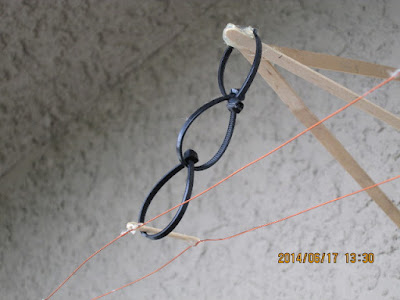 |
| 600 ohm #26 balanced line |
I'll let John tell you a bit more before sending you to his fascinating website, Intuitive Electronics, where you can learn more about his system and the engineering behind his successful, low-noise installation.
When it comes to a high frequency ham station, the antenna alternative chosen by most apartment dwellers is no antenna at all. The design here is a wisp of an antenna that bothers no one and which can work Japan, Australia, France, European and Asian Russia, the Caribbean, Central America, Polynesia and South America from the Pacific coast of Canada. It is a simple solution for apartment dwellers, it is a cheap solution and it causes no t.v.i. or other r.f. problems. It is far preferable to the alternative selected by so many fellow apartment dwellers: no antenna at all.
An implication that it seems to be impossible to rid from the minds of fellows using a Marconi antenna is that they are not just pumping 100 watts of r.f. into their antenna but that they are also pumping that same 100 watts of r.f. into their ground, that is to say the building’s wiring, the safety ground wiring. R.f. in the safety ground is well coupled into the power and neutral conductors of a residence and, in North American code, is even hard connected to the neutral line at the service entrance. The house wiring becomes part of the antenna system.
The ground wiring and everything connected to it is every bit as much a part of the antenna as is the live element. Both radiate just the same amount of r.f. power, fellows. The ground wiring along with every electrical power consumer in the building is worked against the live element. Thinking of what is connected to ground in your house is thinking about one side of your antenna. It’s not just appliances that get the “benefit” of r.f. The land line telephone system, the cable television system, the garage door opener, the security lights and…you name it. They are all “feeling” that 100W of r.f. With regard to r.f., there is no distinction whatsoever to be made between “hot” and “ground”.
You know the reason why vertical antennas have gained a reputation for being noisy on receive now, too. Most verticals are Marconi antennas. Both the safety ground and the neutral serve all the houses in the neighbourhood. The receiver is wired into the electrical appliances of the entire neighbourhood.
This radio station, located four stories above grade and in a wooden building full of apartments would be a worst case for r.f. in “ground”. This station has no r.f. in the station. It has no r.f. in “ground”.
The station has no interference issues. The Building Manager, the Building Superintendent and the administrator for this building’s cablevision have been aware of the station from the beginning. There has not been a single complaint of t.v.i. or any other complaint about the station. That’s a clean record extending back to 2006. There are no red faced, spluttering tenants hammering on the door of this station! At this station, all the r.f. produced by the transmitter makes its appearance out on the antenna. The radio station’s r.f. is not referenced to station ground. Station ground “knows nothing” about the r.f. being generated.
In the present case, that is to say a station to be operated in an apartment building, it is required to have an antenna that is “invisible”. Now it’s not possible to achieve that literally but at least the antenna should be so inconsiderable that there will be no complaints from neighbours about having to look at it. The antenna here is made of #26 A.W.G. wire. That’s wire that is 0.40mm, 0.016 of an inch, in diameter. Four stories up, it’s difficult to see the antenna and that’s even when knowing where to look for it. Part of the antenna’s run is through trees and in among the tree branches it pretty much is invisible. It does not annoy neighbours by casting a shadow; there is no shadow.
In spite if the naysayers, John's small gauge antenna has survived years of winter storms, regular occurrences here on Canada's western edge ... simply because it presents such a low cross-section compared to most conventional antenna wires.
To read more about enjoying your hobby again from your new 'restricted' location and more than likely, learn something new about old fundamentals, give John's website a very close inspection ... there is much wisdom and many gems to be found, even if you don't live in an apartment!
